Reid_in_QC
100 µW
- Joined
- Oct 31, 2021
- Messages
- 8
Hello all. New user here at Endless Sphere but used it as reference often and I've tinkered with small EVs and battery-electric machines here on our working farm for several years.
I picked up a handful of these larger pouch cells at a local recycler who was scared to keep them kicking around his shop full of miscreants and hooligans in nothing but a cardboard box. So worried (and clueless) was he that he put said box outside in the rain
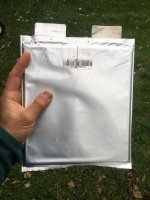
So I hauled them home, dried them off, inspected and repacked them safely. They all look clean and harm-free despite their mistreatment and all have comparable voltage around 3.2V - which doesn't really identify the chemistry conclusively I don't think. I'm having no luck finding specs online for these pouches so I thought I'd ask here if anyone knows tricks for tracking down this kind of info. Also suggestions on how to find suitable separators to assemble a robust pack assembly would be welcome. The cells look big enough to potentially make a decent pack (maybe 3.5kWh total, estimating by weight, for my little hoard) but I need to know more about these cells before I even start testing them.
Pouch dimensions are about 225mm x 265mm x 16mm (8-3/4" x 10-1/4" x 5/8"). (possibly 228x268x12 as per label but they're definitely thicker than 12mm but not swollen. The only identifying marks I could find are the barcode sticker with variable serial below and two consistent codes above: WX12I3267 (26822812A)
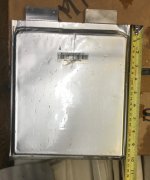
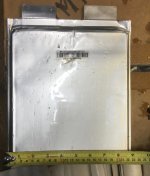
And finally, for bonus points, there was this A123 module sitting at the recycler (who still speaks mostly lead) that I almost made an offer on but instead I snapped a pic to look up more info. Again I haven't been able to identify it's original application or confirm the figures on the nameplate. Anyone know what this came out of or if the figures sound right? Looks awfully small to me for 6.8kWh. I didn't take dimensions I'm afraid but the clamp-type multimeter in the shot is a small one.
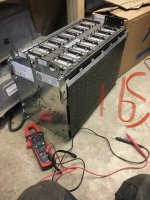
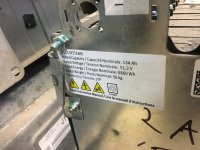
And gotta use it because it's there... ! now that's an emoticon worth creating! :lol:
! now that's an emoticon worth creating! :lol:
Thanks in advance for any insights on these pouches of mystery
I picked up a handful of these larger pouch cells at a local recycler who was scared to keep them kicking around his shop full of miscreants and hooligans in nothing but a cardboard box. So worried (and clueless) was he that he put said box outside in the rain

So I hauled them home, dried them off, inspected and repacked them safely. They all look clean and harm-free despite their mistreatment and all have comparable voltage around 3.2V - which doesn't really identify the chemistry conclusively I don't think. I'm having no luck finding specs online for these pouches so I thought I'd ask here if anyone knows tricks for tracking down this kind of info. Also suggestions on how to find suitable separators to assemble a robust pack assembly would be welcome. The cells look big enough to potentially make a decent pack (maybe 3.5kWh total, estimating by weight, for my little hoard) but I need to know more about these cells before I even start testing them.
Pouch dimensions are about 225mm x 265mm x 16mm (8-3/4" x 10-1/4" x 5/8"). (possibly 228x268x12 as per label but they're definitely thicker than 12mm but not swollen. The only identifying marks I could find are the barcode sticker with variable serial below and two consistent codes above: WX12I3267 (26822812A)


And finally, for bonus points, there was this A123 module sitting at the recycler (who still speaks mostly lead) that I almost made an offer on but instead I snapped a pic to look up more info. Again I haven't been able to identify it's original application or confirm the figures on the nameplate. Anyone know what this came out of or if the figures sound right? Looks awfully small to me for 6.8kWh. I didn't take dimensions I'm afraid but the clamp-type multimeter in the shot is a small one.


And gotta use it because it's there...
Thanks in advance for any insights on these pouches of mystery


